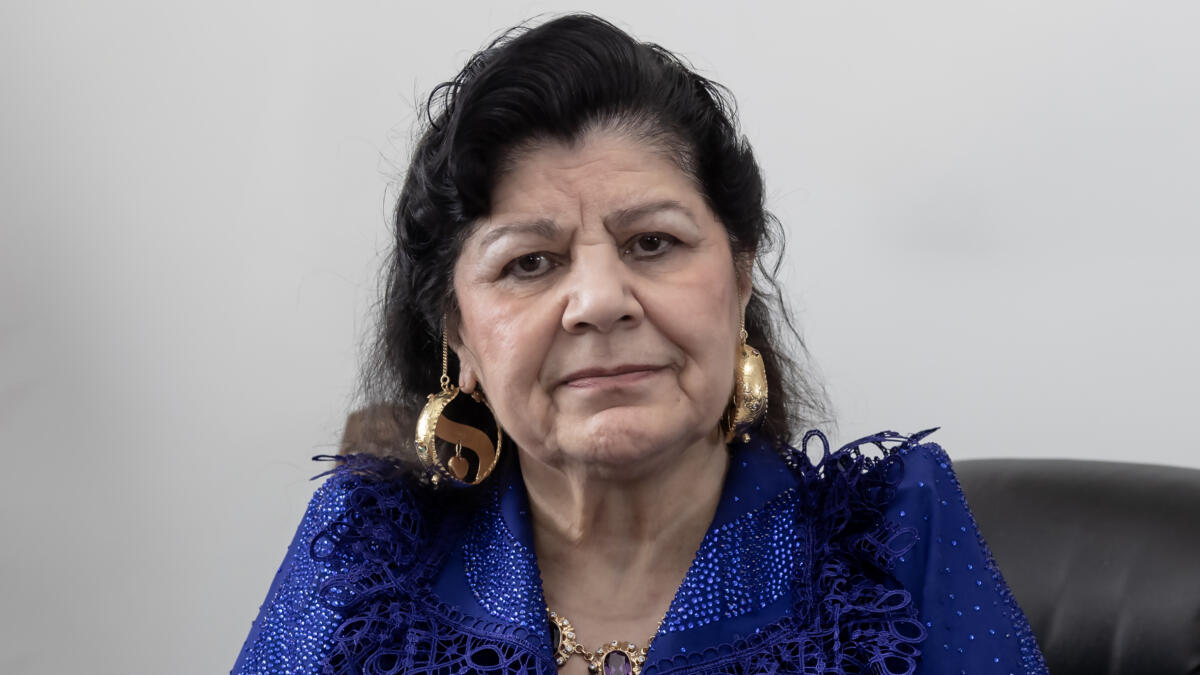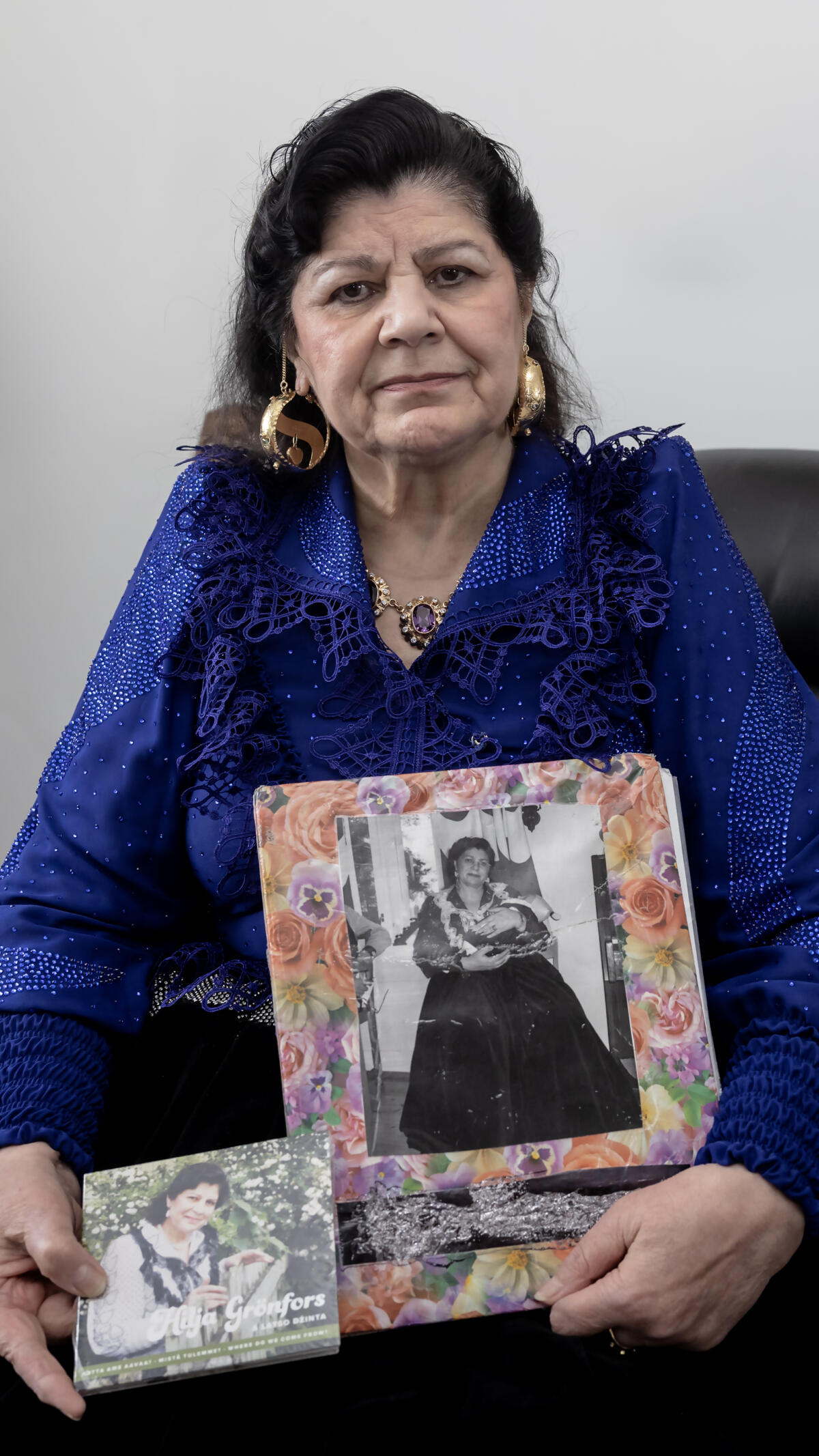Honorary doctor Hilja Grönfors: A child who sang out her happiness
Musician Hilja Grönfors has carried out a vast and exhaustive project as a collector and performer of the Romani music heritage. She is one of the recipients of honorary doctorates at Uniarts Helsinki. The modest artist has never expected any awards for her work.

A small, red car was in a downright conspicuously bad condition. Nevertheless, the car somehow managed to keep going, with a guitar, notebook and pen on the scruffy back seat.
“I felt like collecting these songs was my duty. A mission that I had been given,” says musician Hilja Grönfors.
The songs refer to traditional Romani songs sung in Romani or Finnish, which have been – and still are – at the risk of disappearing. Grönfors has done tremendous work already since the ‘90s in order to collect and preserve examples of intangible cultural heritage of the Romani people.
In her small red car, she drove across Finland and met with old men and women representing various Romani families. Grönfors played guitar in houses and at events and lured the songs out of people. Grönfors did not use a computer or tape recorder for her work, and that has remained the case to this day. In fact, she wrote down the lyrics of the songs by hand. Grönfors memorised the melodies, because she did not have a grasp of musical notation.
“I have never expected awards for my work,” Grönfors says modestly.
But she has received them anyway: For example, Grönfors received the title Master Folk Singer at the Kaustinen Folk Music Festival in 2005. In 2011, she received the Kalevala Prize, and in 2014, she was awarded the Finland Prize for her work for Romani culture. This August, Grönfors will be awarded the title of honorary doctor at Uniarts Helsinki conferment ceremony.
Grönfors says she considers this a great honour but finds herself slightly bewildered by the recognition.
“I’m just a normal person. But, of course, I’m also very delighted and grateful for this.”
Knowledge passed on through music
As a child, Grönfors’ family of twelve moved a lot. This was usual also for other Romanis at the time. Adults travelling with wagons and sleighs used to sing songs, while little Hilja sat aboard and listened to them. People met up with other families on their travels, and music was present everywhere. Grönfors felt a strong pull towards it – if there was music playing somewhere, Hilja was sure to be there, too.
“Most of the traditional melodies surely stuck with me already from these times. It has helped a lot in my song collection work,” Grönfors presumes.
The songs talked about love, travelling, imprisonment or longing, for example, or they were so-called market songs (markkinalaulut in Finnish). People also sang songs about the might and power of their big and powerful family (mahtilaulut in Finnish). Grönfors explains how the songs were passed on among the Romani people through generations as heritage. Through the lyrics, people have shared valuable information about the community’s customs and traditions as well as instructions from adults to children, teaching them how to lead a good life.
In Romani music, not everyone gets to sing the same songs. Men’s songs about fairs and might are not suitable for women, and it is not appropriate for men to perform songs intended for women, either.
Over the years, Grönfors has evolved into an esteemed performer who is allowed to make exceptions to these rules. She was very cautious in her early days, however.
“I barely had the guts to sing some of the songs with half of my mouth, because I was afraid I was insulting our traditions by performing them,” Grönfors notes.
As the generations changed and Romani people began to lead a less travelling lifestyle, many songs and their lyrics began to fade away. The melodies began to change, too. This became apparent for Grönfors in a Romani language teacher course in 1996. The course’s twelve students with a Romani background were all musically skilled, but none of them knew how to sing even one song from beginning to end. Grönfors had personally grown up surrounded by the singing tradition, and she realised that the tradition was facing extinction.
“Somehow, I got an epiphany of sorts and knew that I needed to fix the situation. I shouldn’t keep the songs I already knew just to myself.”
When the course ended, Grönfors packed up her car and hit the road. Thanks to her selfless work, there are now recordings of about 130 songs, some of which have also been notated at the Sibelius Academy and compiled into two music books with notations.
There is more on the way, because Grönfors continues to go around searching for songs and hunting for lost lyrics.
“There are still many songs out there that wait to be collected. My goal is to get all of them notated.”

A child who sings out her happiness
Grönfors’ influence on the Romani culture is not limited to just collecting songs. She is also a distinguished musician and performer, who says that she has music and singing in her blood.
“They said I sang already before I knew how to speak properly. My parents wondered what kind of child they had,” Grönfors says with a happy twinkle in her eyes.
“I remember how my grandma said that this child sings out her happiness. I’ve often wondered what my grandma actually meant. Do I sing myself happy or do I sing the happiness out of myself?”
Nobody in the family had the sense to encourage the child to pursue music studies, however. At school, the teacher recognised that Grönfors was gifted, but that alone was not enough to help the girl forward.
At times, Grönfors says she wonders how different her path could have been if it had been possible for her to study at a music institute and then go on to a conservatoire and the Sibelius Academy. “Then again, I am not sure if encouragement alone would have changed anything at the time,” she says.
“After all, us Roma people weren’t wanted anywhere. After comprehensive school, I applied to study at many places, but I was only admitted to a folk high school,” Grönfors says.
Even today, it is not unwarranted to ask how equal the chances that young Romani people have are compared to the majority of the population when it comes to higher education in the arts, for example. Grönfors believes that many Romani people would have a tremendous amount of talent to give to the field.
“I would encourage them to go and pursue their aspiration. But it takes courage and persistent work also from the young people themselves.”
Grönfors thinks that the current general atmosphere is, in some regard, more kind to minorities, but among some people, old attitudes die hard.
“I, of course, want our culture to leave a mark, and I try to record the songs that I collect as the versions that have been passed on, as genuine and unchanged versions,” she says.
“But at the same time, I hope to create a new and a different image of the Roma through my own example and inspire people to think of new possibilities.”
Heavens open in Sweden
When Grönfors was about twenty years old, her whole family moved from the recession-ridden Finland to Sweden to look for work. Grönfors describes life in Stockholm in the ‘70s as heavenly. There was no discrimination against the Romani people, jobs could be found right way and people could do as much work as they felt like doing.
“It was unbelievable. Soon we could afford living in a five-room apartment, which felt like an actual palace.”
In Finland, her people already knew that she was a skilled singer, and soon this was noticed also within the Swedish Romani community. She was a sought-after performer at parties and ended up singing both on the Swedish radio and television.
“I was also offered the chance to go sing in Germany, for example, but back then, I didn’t understand the value of this opportunity,” Grönfors says.
While living in Sweden, Grönfors became a mother, which began to influence her life choices. At one point, she even tried to intentionally disengage from music and avoid the desire she felt towards it. There were responsibilities and obligations that outweighed her dreams in her life. Grönfors returned to Finland when her son was close to school age.
“I didn’t want to raise him in the bustle of a big city, and my parents had already moved back here, too. It felt safer to return to my home country to live together with my loved ones.”
A village festival with far-reaching consequences
One of her talents since adolescence has also been sewing, and she sewed dresses for Romani people alongside her other work. She has travelled to Turkey and France, for example, to acquire fabulous fabrics for the clothes she has made.
After one long fabric purchase trip, Grönfors got a call from her cousin Raila Halmetoja, who worked as a journalist for the Finnish Broadcasting Company. She asked Grönfors to perform at the Kumpulan Kyläjuhlat Festival later in the evening on the same day.
“I was tired, I had come back home from Turkey late at night and I really didn’t feel like going. But Raila was persistent, she didn’t give up but insisted and pleaded,” Grönfors reminisces and looks slightly amused.
Whether one believes in fate or not, this one performance changed the direction of Grönfors’ life completely. She performed five songs at the event, and they were recorded, as well.
This new musical beginning as a performer coincided with her realisation that the Romani music tradition was about to disappear. Things were intertwined, loose ends were tied up. Grönfors collected lost songs and also performed them. Music started to play an increasingly big role in Grönfors’ life.
Her first album with traditional Romani songs, titled Phurane Mirits, was released in 2008. It was awarded a Finnish music award called Etno-Emma. The same year marked the release of a documentary about Grönfors and the history of the Romani people in Finland, titled This Country Was Not Mine, directed by Katariina Lillqvist. Folk music and global music scenes snapped awake.
“The Finnish Romani music has remained more pure and original compared to the rest of Europe, where it’s partially mixed with new schlager music,” Grönfors explains.
Since then, Grönfors has toured and performed at various international festivals both in Finland and abroad as well as at more small-scale events and released three albums under her own name. She has also been featured on various recordings, collaborated with various orchestras and other artists, including rap artist Paleface, and made Romani music more well-known through school visits, for example. Besides making her personal renditions of traditional songs, Grönfors also composes and writes new music.
In addition to the music scene, Grönfors is also engaged in the activities of the Romani Culture Museum located at the old Lapinlahti Hospital in Helsinki and acts as the chair of the museum. In theory, Grönfors has retired, but she is certainly not resting on her laurels.
“I love music, I live and breathe it. When I was little, I dreamed of becoming a big star, maybe an opera singer. Maybe it’s not too late yet to become one.”
Text: Elli Collan
Uniarts Helsinki conferment event, the ceremonial conclusion of university studies, will be held in Helsinki from 16 to 18 August 2024. The ceremony will feature the conferment of degrees on master’s graduates and doctors from the university’s academies. Additionally, honorary doctorates will be conferred on eight individuals who represent Finnish or international pioneers and influential figures in their fields and who have advocated for arts education or advanced the societal role and significance of the arts.
The honorary doctors have been selected by the boards of the Academy of Fine Arts, Sibelius Academy and Theatre Academy and the university board of the University of the Arts Helsinki. Being conferred an honorary doctorate is the highest recognition bestowed by the university.
